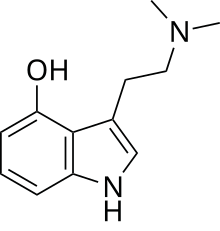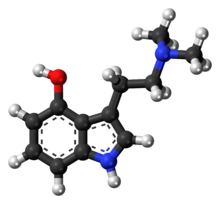Psilocine
| Psilocine | ||

| ||
 | ||
| Formule topologique (haut) et modèle compact (bas) de la psilocine | ||
| Identification | ||
|---|---|---|
| Nom UICPA | 4-hydroxy-N,N-diméthyl-tryptamine | |
| Nom systématique | 3-[2-(diméthylamino)éthyl]-1H-indol-4-ol | |
| Synonymes |
4-HO-DMT, 4-hydroxy DMT |
|
| No CAS | ||
| No ECHA | 100.007.543 | |
| SMILES | ||
| InChI | ||
| Apparence | poudre cristallisée blanche | |
| Propriétés chimiques | ||
| Formule | C12H16N2O [Isomères] |
|
| Masse molaire[1] | 204,268 2 ± 0,011 4 g/mol C 70,56 %, H 7,9 %, N 13,71 %, O 7,83 %, |
|
| Caractère psychotrope | ||
| Catégorie | Hallucinogène psychédelique | |
| Mode de consommation |
Ingestion |
|
| Autres dénominations |
voir Psilocybe |
|
| Risque de dépendance | Nul | |
| Composés apparentés | ||
| Autres composés | ||
| Unités du SI et CNTP, sauf indication contraire. | ||
| modifier |
||
La psilocine est une molécule hallucinogène extraite de divers champignons (psilocybe, stropharia, etc.) qui poussent naturellement dans les pays tropicaux et dans certains pays tempérés.
Elle est formée dans le corps de la psilocybine par ségrégation du groupe de phosphate (déphosphorylation), grâce aux enzymes phosphatases alcalines, et représente la substance psychoactive réelle (environ 1,4 fois plus efficace que la psilocybine).
Il s'agit d'une substance proche de la bufoténine appartenant au groupe des tryptamines hallucinogènes.
Son nom chimique est 4-hydroxy-N,N-diméthyltryptamine, parfois abrégé en 4-HO-DMT.
Historique
[modifier | modifier le code]La psilocine a été isolée par Albert Hofmann en 1959.
Pharmacologie
[modifier | modifier le code]La psilocine interagit principalement avec les sous-types de récepteurs sérotoninergiques 5-HT1A, 5-HT2A et 5-HT2C : c’est un agoniste mixte de ces récepteurs.
Législation
[modifier | modifier le code]La psilocine est une substance réglementée, citée au tableau I de la Convention sur les substances psychotropes de 1971.
Notes et références
[modifier | modifier le code]- Masse molaire calculée d’après « Atomic weights of the elements 2007 », sur www.chem.qmul.ac.uk.
Voir aussi
[modifier | modifier le code]Text is available under the CC BY-SA 4.0 license; additional terms may apply.
Images, videos and audio are available under their respective licenses.
